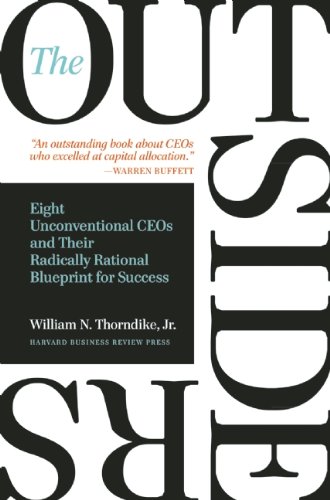

This article is an excerpt from the Shortform summary of "The Outsiders" by William N. Thorndike, Jr. Shortform has the world's best summaries of books you should be reading.
Like this article? Sign up for a free trial here .
What is capital allocation, and how does it work? Why does a strong capital allocation strategy make for a great CEO?
Capital allocation is the practice of distributing and investing a company’s resources in a way that will make further profits. For the Outsider CEOs, an unorthodox capital allocation strategy was the building block on which they developed other strategies that resulted in higher profits.
What Is Capital Allocation?
In general, CEOs have to do two things to succeed:
- Run operations efficiently to generate cash.
- Deploy the cash productively.
Most CEOs and most management books focus on the former. In contrast, Henry Singleton of Teledyne and the other outsider CEOs in the book focused on the latter. Rather than seeing themselves as company operators, the outsider CEOs saw themselves as investors and capital allocators first and foremost.
Despite the importance of capital allocation, little training is devoted to it. Business schools don’t feature capital allocation strategy in curricula, and CEOs are promoted from functional roles (like product or marketing) without strong experience with investment in the business. Outsider CEOs saw it as their core job.
Unique Capital Allocation Strategies of Top CEOs
As a baseline, businesses can deploy cash in five basic ways—invest in the existing business, acquire other businesses, pay dividends to shareholders, pay down debt, or buy back stock. They can also raise money by issuing debt or raising equity. These are all tools in capital allocation, and the specific usage of these tools determines a company’s performance.
How to decide between these options? Universally, outsider CEOs were rational—they calculated the return on each investment project, then made the most profitable choice. They ignored conventional wisdom and what their peers were doing.
Compared to their peers, outsider CEOs tended to allocate capital differently:
- They aggressively bought back company stock when it was cheap (for instance, when price-to-earnings ratio was in single digits). This would increase earnings per share and, consequently, price per share.
- They rarely issued shares to raise funds, preferring to avoid dilution.
- They rarely issued dividends, seeing this as a tax-inefficient way of rewarding shareholders. Dividends are essentially taxed twice, first as corporate tax on earnings, then as personal tax on capital gains.
- They were judicious about acquisitions. They didn’t acquire companies out of empire-building ego, with little care for cost. Instead, they bought companies only when it was a good deal; many had hard rules for what to buy, for instance based on a maximum P/E ratio or projected rate of return.
- This didn’t mean timidness—outsider CEOs were capable of making large, bet-the-company acquisitions when they felt it was a high-probability bet. Every CEO in the book made an acquisition worth at least 20% of their company’s enterprise value.
Outsider CEOs thought about their companies as investors and made cool, rational decisions based on what provided the best returns. Ego and a desire to build empires were never part of the decision.
In contrast, typical CEOs issued shares to fund costly acquisitions, preferred not to buy back stock or raise debt, and paid dividends frequently. In the conglomerate era, they aggressively acquired companies believing they could improve profits through scale or synergies; this was often a mirage that never materialized. All these activities tend to result in lower performance by the author’s favorite metric—price-per-share.
Note that the optimal choices vary from company to company, from industry to industry, and between different time periods. The point is not to blindly mirror what the outsider CEOs did—it’s to examine all of the tools in your toolkit, and choose the best one based on rational analysis.
Capital Allocation: Examples from Outsider CEOs
The top Outsider CEOs used the capital allocation process in creative ways. Here are some capital allocation method examples that outsiders CEOs used that came to define their company and their tenure as CEO.
Bill Stiritz: Ralston Purina
Stiritz took a quantitative approach to management. A poker player in his youth, he saw the capital allocation process like poker—read the table, calculate odds, and know when to bet big when you’re likely to win. He would use his quantitative approach in capital allocation strategy, such as deciding between repurchasing shares and conducting an acquisition, based on return on investment.
He saw analysis as critical to independent thinking, particularly in the CEO position. He felt that CEOs who lacked an analytical mindset (for instance, if they came from areas like marketing or legal) were handicapped in their role.
His last two moves were defining moments:
- In 2000, he spun off Energizer Holdings, which then represented 15% of Ralston’s enterprise value. This left Ralston with a sole focus on pet food.
- In 2001, he negotiated a sale of Ralston to Nestle for $10.4 billion, or 14-times cash flow.
Dick Smith: General Cinema
Smith collaborated closely with three top executives: his CFO, COO, and legal counsel. They actively debated company strategy, and Smith invited them to publicly disagree with him, even in front of the board.
As with other outsider CEOs, Smith left day-to-day operations to his three top executives, instead focusing on strategy and capital allocation methods.
In general, for capital allocation strategy, Smith behaved like other outsider CEOs in these ways:
- He avoided issuing stock, holding onto shares like “a feudal lord.”
- He paid little in dividends.
- He repurchased a third of General Cinema shares over time, with an internal rate of return of 16%.
- He preferred to focus on cash earnings, not reported income.
- He used debt to fund acquisitions, with debt-to-cash flow of 3 times or more.
- He minimized taxes, enjoying a reduced rate of 33% compared to the nominal corporate tax rates of 50%.
Warren Buffett: Berkshire Hathaway
Like most other outsider CEOs, Buffett is completely centralized in the capital allocation process. All capital flows to headquarters to allocate. Buffett personally takes charge of negotiations, and he does not rely on investment bankers or business development to make deals.
Buffett also believes in having a relatively small board, and requiring all board directors to have a personal stake in decisions. This means:
- A meaningful investment of personal capital into the business
- No insurance
- Avoiding fees that represent a large percent of the director’s income
This aligns board members much better with the performance of the business. In contrast, board members who have little ownership in the business, have insurance that protects them from downside, and are paid large fees are far less interested in guiding the company correctly.
When making capital allocation strategy or capital allocation method decisions, outsider CEOs avoided complicated financial models and pages of analysis, which they knew to be imprecise. Instead, they tended to simplify understanding of a business down to a handful of key assumptions—market growth trends, competitive dynamics, and cash flow. This allowed them to make fast decisions when an opportunity appeared.

———End of Preview———
Like what you just read? Read the rest of the world's best summary of William N. Thorndike, Jr's "The Outsiders" at Shortform .
Here's what you'll find in our full The Outsiders summary :
- What great CEOs like Warren Buffett do that average CEOs don't
- How to master the art of capital allocation
- How to be a great manager that your team is excited to work with






